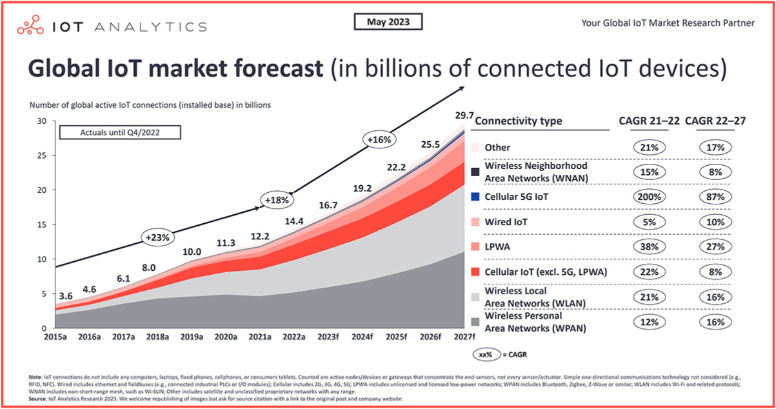|
WiFi for IoT
We have long been using WiFi just as a technology to connect my laptop and mobile phone to the internet, but the technology does not stop there. Nowadays, WiFi is also a key part of the Internet of Things (IoT), linking not just our phones and computers, but also many devices in our homes and workplaces. This includes everything from light bulbs that you can control with your smartphone to smart thermostats that learn your schedule. WiFi makes it easy for these devices to communicate with each
other and with the internet, making our lives more convenient. By bringing all these different gadgets together, WiFi is opening up new ways for us to interact with the technology around us, making our environments smarter and more responsive to our needs.

In this note, I am going to talk about how WiFi is used for IoT and overcome various technical challenges for the application.
Today, we live in a world where WiFi and Internet of Things (IoT) devices are everywhere. It's not something from a science fiction story. It's real. These devices make our homes, work, and even the outdoors better and smarter. They connect and talk to each other, making things easier for us. Below is a table with many different kinds of these smart devices. It shows us that the future of smart technology is already here. We use these amazing devices every day. They help us in so many ways,
from keeping our homes safe to making sure we're healthy.
|
Category
|
Device Type
|
Description
|
|
Smart Home
|
Smart Thermostats
|
Adjusts home temperature remotely, learns habits for energy savings.
|
|
Smart Home
|
Smart Refrigerators
|
Tracks groceries, suggests recipes, and displays family calendars.
|
|
Smart Home
|
Smart Locks
|
Allows remote locking/unlocking of doors, and guest access via smartphones.
|
|
Smart Home
|
Smart Lights
|
Remote and automated control of home lighting, including color changes.
|
|
Smart Home
|
Smart Speakers
|
Voice-activated devices for music, information, and home control.
|
|
Smart Home
|
Smart TVs
|
Internet-connected TVs for streaming and smart home control.
|
|
Smart Home
|
Home Security Cameras
|
Remote monitoring of home for security purposes.
|
|
Smart Home
|
Smart Coffee Makers
|
Brew coffee remotely or schedule brewing times.
|
|
Smart Home
|
Robot Vacuums
|
Automated home cleaning, controllable via smartphone apps.
|
|
Smart Home
|
Smart Ovens
|
Remote preheating and cooking monitoring, recipe suggestions.
|
|
Smart Home
|
Smart Irrigation Systems
|
Automated and weather-responsive garden watering systems.
|
|
Smart Home
|
Smart Plugs
|
Turn any device into a smart device, remote on/off switching.
|
|
Smart Home
|
Smart Smoke Detectors
|
Sends alerts to your phone if smoke or CO is detected.
|
|
Smart Home
|
Smart Doorbells
|
Video doorbells that allow remote visitor interaction and monitoring.
|
|
Smart Home
|
Smart Window Blinds
|
Automated or remote control of blinds for light and privacy management.
|
|
Smart Home
|
Smart Air Purifiers
|
Monitor and clean air quality, controllable via smartphones.
|
|
Smart Home
|
Smart Pet Feeders
|
Schedule and remotely control feeding times and portions for pets.
|
|
Health/Fitness
|
Smart Watches
|
Wearable devices for health tracking and notifications.
|
|
Health/Fitness
|
Fitness Trackers
|
Track activity, sleep, and health metrics, sync with smartphone.
|
|
Health/Fitness
|
Smart Bathroom Scales
|
Measures weight, body fat, and other health metrics, syncs with apps.
|
|
Outdoors
|
Smart Gardening Systems
|
Monitors plant health, waters plants automatically based on soil moisture.
|
|
Outdoors
|
Outdoor Surveillance Cameras
|
Enhanced security for outdoor areas, remote monitoring, and motion detection.
|
|
Automobile
|
Smart Car Adapters
|
Plugs into a car's OBD-II port to provide diagnostics, tracking, and efficiency tips.
|
|
Automobile
|
Tire Pressure Monitoring Systems
|
Sends real-time tire pressure information to a smartphone app.
|
|
Industry
|
Industrial IoT Sensors
|
Monitors machinery health, environmental conditions, and operational efficiency in real-time.
|
|
Industry
|
Smart Logistics Trackers
|
Tracks shipping containers and goods, providing real-time location and condition monitoring.
|
WiFi-connected devices are everywhere, and they're a big part of our world now. These numbers show us how fast they are growing. We're going to look at just how many smart devices are out there today and what this means for our future.
The chart below illustrates the global IoT market forecast, showing the number of connected IoT devices in billions up to the year 2027. It differentiates between actual data up to Q4/2022 and projected growth beyond that. A Compound Annual Growth Rate (CAGR) is given for two periods: 2021-2022 and 2022-2027, across various connectivity types like 5G IoT, LPWA, and WLAN. The CAGR shows the expected annual growth rate in percentage for each connectivity type. The overall trend indicates
a significant increase in IoT connections, with a notable rise in cellular 5G IoT connections.
NOTE : Even though every access technology is growing for IoT, WLAN/WPAN is still dominant technology and the situation would not change.

Source : IoT Business News
Do we need a specific variants of WiFi for IoT ? or is it same as regular WiFi ?
IoT devices can use regular WiFi, but there are also specific WiFi standards designed for IoT applications. Regular WiFi can be used for devices that need higher data rates and have more power, like smart TVs and cameras. For IoT devices that need less power and have lower data requirements, like sensors and smart bulbs, WiFi variants like WiFi HaLow (802.11ah) are more suitable because they offer longer range and can connect to more devices. This helps save energy and extends the life of the
device's battery.
There are a few reasons why specialized variants of WiFi have emerged for specific IoT use cases:
- Key Differences:
- Power Consumption: IoT devices often need to run on batteries for long periods. Regular WiFi can be too power-hungry. Specialized IoT WiFi variants, like Wi-Fi HaLow (802.11ah), focus on low-power operation to extend device battery life.
- Range: Many IoT applications need extended range to cover sensors in a factory or farm. Wi-Fi HaLow is optimized for longer distances than standard WiFi.
- Number of Devices: Regular WiFi might struggle with a large number of connected IoT devices. Newer generations of WiFi (like WiFi 6 and WiFi 6E) are better equipped to handle dense device environments, improving IoT stability.
- When can I Use Regular WiFi for IoT ?
- For many home IoT applications, regular WiFi works perfectly fine. Here's when regular WiFi might be sufficient:
- Home Environment: Smart lights, thermostats, cameras in your home likely function well on regular WiFi.
- Limited Devices: If you have just a few IoT devices, your standard WiFi should handle it perfectly.
- Power Availability: If your IoT device has consistent access to power (not battery-operated), a standard WiFi connection might work just fine.
- When Specialized WiFi Might Be Better ?:
- Battery-Powered Devices: If power conservation is crucial, Wi-Fi HaLow or other low-power options might be necessary.
- Large Areas: Industrial settings, agriculture, or outdoor IoT deployments needing better range would benefit from Wi-Fi HaLow.
- Dense Device Networks: Warehouses, hospitals, etc., with many IoT devices may require the greater scalability and features of WiFi 6/6E.
Integrating WiFi into IoT devices brings its own set of hurdles. In this section, I am going to explores the intricate technical challenges—from power management and signal reach to ensuring secure and seamless communication among a multitude of diverse devices—underpinning the sophisticated world of WiFi IoT.
- Power Consumption:
- Many IoT devices are battery-powered, requiring long battery life. Regular WiFi can be power-hungry, draining batteries quickly.
- Techniques like power-saving modes and optimized sleep/wake cycles are needed to conserve energy.
- Range:
- Standard WiFi's range might be insufficient for applications like smart agriculture or industrial monitoring, where sensors are spread out over large areas.
- Solutions like WiFi HaLow (802.11ah) cater to long-range requirements but may have trade-offs in data rates.
- Scalability:
- Home WiFi networks struggle when overwhelmed with a large number of IoT devices competing for bandwidth.
- Newer WiFi standards (WiFi 6/6E) introduce technologies to manage more devices efficiently, but older routers create bottlenecks.
- Security:
- IoT devices are potential entry points for cyberattacks. Weak security protocols on devices or in network configuration leave systems vulnerable.
- Robust encryption, secure authentication, and regular updates are essential for IoT security over WiFi.
- Interference:
- The 2.4 GHz band (frequently used by WiFi) is crowded with Bluetooth devices, microwaves, etc., causing interference and affecting IoT device reliability.
- WiFi 6 and 6E use less congested frequency bands (5 GHz, 6 GHz) to mitigate interference, promoting greater stability.
- Connectivity in Harsh Environments:
- Industrial or outdoor IoT deployments expose devices to extreme temperatures, vibrations, and dust. WiFi equipment needs to be designed to withstand these challenges.
- Device Management and Updates:
- A large-scale IoT system requires managing many devices remotely, deploying software updates, and ensuring configurations are updated over WiFi. This needs seamless orchestration.
- Additional Considerations
- Cost: Low-power WiFi variants can be costlier to implement for small-scale IoT projects.
- Limited Expertise: Specialized WiFi IoT protocols and features might require specialized knowledge for proper implementation.
Reference
|
|

